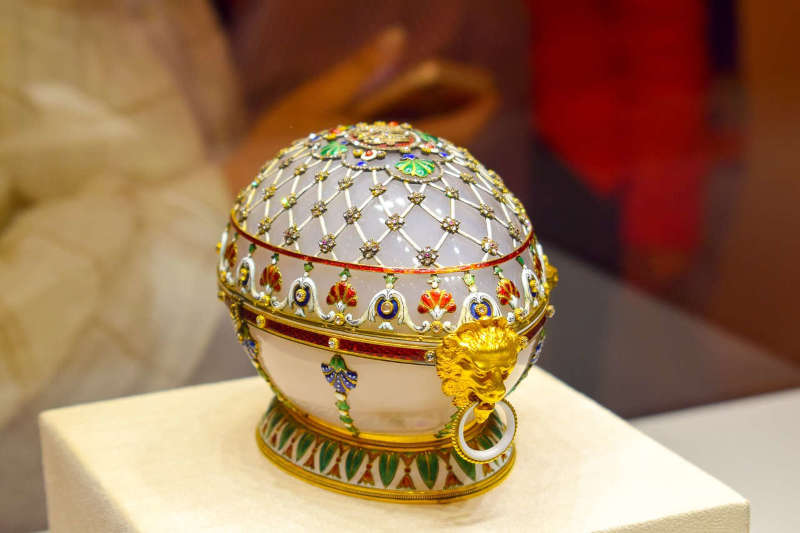
× 
The spectacular Fabergé Egg has a rich history. But how much does the most expensive Fabergé Egg cost?
We can tell you now that the most expensive Fabergé Egg once had a valuation of a cool $33m! But which Fabergé Egg was it?
First, here's a little information about the story behind these iconic creations.
What is a Fabergé Egg?
The jewellery company House of Fabergé, based in Saint Petersburg, began in 1842
The jewellery company House of Fabergé, based in Saint Petersburg, began in 1842. While Gustav Fabergé founded the firm, his son Peter Carl would oversee the creation of almost all these now famous and iconic eggs.
Made between 1885 and 1917, there were once 69 eggs, with estimates suggesting that 57 still exist today.
Needless to say that at Westland London, while we have many fine premier antiques in stock, we don't sell Fabergé Eggs! Those that are not lost are now in private collections or museums, while some are sitting in the homes of very lucky individual owners.
The most well-known are the Imperial eggs - there were 52, of which 46 survive. Created for Russian tsars Alexander III and Nicholas II, the stunning jewelled eggs were Easter presents for their wives and mothers.
The first Fabergé Egg
It opened to reveal a 'surprise' - a gold yolk design containing a small hen sitting on straw
In the year 1885, Peter Carl Fabergé created the Hen egg. It opened to reveal a 'surprise' - a gold yolk design containing a small hen sitting on straw, all gold as well.
The hen also had a surprise - inside there was a miniature diamond Imperial crown plus a ruby pendant. The egg was a present from Alexander III to his wife.
The egg was a resounding success for the House of Fabergé. Just a few weeks later, it formally became a supplier as a 'goldsmith by special appointment' to the Imperial Crown.
Alexander III commissioned another egg for the following year. Allegedly, Peter Carl had free reign to choose a design, as long as each egg was unique and contained a surprise inside.
This second Imperial egg is known as the Hen with Sapphire Pendant. While today the Hen egg has an owner, the subsequent Hen with Sapphire Pendant egg is lost.
Until relatively recently, it appeared the 'third' Imperial egg was lost too. That all changed in 2011 when it was re-discovered, having gone missing during the second half of the 20th century.
The most expensive Fabergé Egg
We do know that the egg once had a $33m valuation
A scrap dealer found it in America - then it sat in his kitchen for several years!
Shortly after it was identified by Wartski and now it's the most expensive Fabergé Egg ever, known simply as the Third Imperial Easter egg.
A collector purchased it for an undisclosed amount in 2014, but we do know that the egg once had a $33m valuation.
It has a solid 18k gold case covered in sapphires and diamonds. Inside the egg, there's also a 14k gold Vacheron Constantin Lady's watch - it has a white enamel dial with openwork diamond-set gold hands.
Designed in the Louis XVI style, Alexander III presented it to his wife Maria Feodorovna on Orthodox Easter back in the year 1887.
Here are some of the most expensive Fabergé Eggs in the world:
- Third Imperial Easter, from 1887, valued at $33m
- Rothschild Clock, from 1902, valued at $25.1m
- Imperial Coronation, from 1897, valued at $18m
- Winter, from 1913, valued at $15.6m
- Bay Tree, from 1911, valued at $15m
So as you can see, the typical Fabergé Egg price, for one of the most coveted designs, is several million!

× 
Final thoughts
Watch out for imitations on the market
Alexander III died in 1894, the year of the 10th Imperial egg. His son, Nicholas II, continued the tradition and presented many eggs in the following years to either his wife or his mother.
A few private clients also commissioned Fabergé to create similar eggs, including the Rothschild family.
As mentioned, we don't have Fabergé Eggs here at Westland. And if you're a collector, as Christie's advises, watch out for imitations on the market.
But if you're interested in antiques from this period, take a look at our collection of Victorian and Edwardian era pieces, including fireplaces.
And staying with jewellery and decorations, check out our antique jewelry identification guide or even our to learn more about the wide range of imprinted symbols.
Our latest stock is here and if you have any queries, please don't hesitate to contact us.